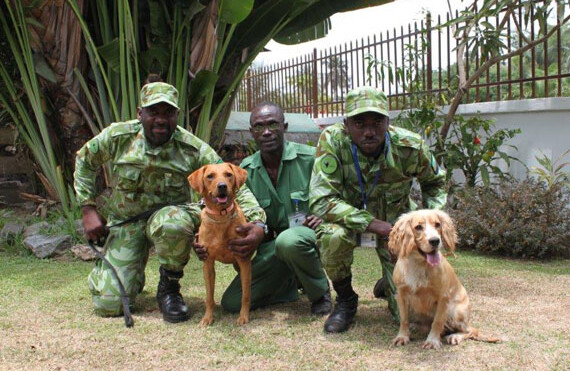Dogs live in an astonishing olfactory world, using their keen noses to detect bombs, drugs, or even the apple you left in your luggage. Canines are ubiquitous in the world's airports, and now conservation practitioners are using their sense of smell to seek out and protect rare turtles, identify individual tigers, find invasive snakes, and sniff out deadly snares.
Our furry friends are also being recruited into the fight to end elephant poaching across Africa by sniffing out concealed ivory.
Between 1980 and 2012, Africa's elephant population dwindled from 1.2 million to about 420,000. My colleagues at Wildlife Conservation Society, Samantha Strindberg and Fiona Maisels, recently reported on a study they led documenting the staggering loss of 65 percent of African forest elephants in the past decade alone. Without swift action, we face the real possibility that elephants will join their cousins, the mammoths and mastodons, in the hall of extinct species.
The burgeoning middle class in China and other parts of Asia has fueled the slaughter of Africa's elephants. Growing disposable income and a sense that ivory signifies wealth has driven the demand for ivory products. While most ivory trade is illegal, a small legal market, and poor enforcement both in China and along the supply chain, has opened the floodgates to illegal trafficking. The trade is driven by the same criminal cartels that traffic in drugs, guns, and humans in China and other parts of Asia.
Unfortunately, demand for ivory shows little sign of abating. Poachers killed some 35,000 African elephants for their tusks in 2012, the worst carnage since the international ivory trade was banned in 1989. That rate of slaughter equates to 96 elephants per day (roughly one every 15 minutes).
 Lumi searches containers at Owendo Port. CREDIT: Ruth Starkey © WCS
Lumi searches containers at Owendo Port. CREDIT: Ruth Starkey © WCS
To raise awareness of this carnage, Wildlife Conservation Society launched 96 Elephants, a public advocacy campaign that now involves more than 100 partners. At a meeting of the Clinton Global Initiative in September 2013, the heads of state of 11 African countries, along with a broad coalition of civil society actors, called on consumer and transit countries to implement a moratorium on the sale of ivory until elephant populations rebound.
We must stop the killing, stop the trafficking, and stop the demand.
Stopping the killing requires boots on the ground, eyes in the sky (drones, planes, and helicopters), and working alongside and in partnership with ecoguards, rural communities, and government officials. Stopping the demand means we need to get people to stop thinking of ivory as a luxury good, and start associating "blood ivory" with dead elephants.
But how do you stop the trafficking? Once an elephant is killed, and the ivory moves into transit, it's easy to hide few hundred tusks in a false compartment in a shipping container when that container sits in a port with tens of thousands of nearly identical containers.
In recent years, dogs trained to sniff out ivory have shown to be especially effective in addressing the trafficking issue. The deployment of these "sniffer dogs" at key transit points—on roads, in ports, and in airports—has proved as useful in the fight to protect elephants as radio collaring on the ground and population monitoring from airplanes and helicopters.
WCS has been the driving force behind a sniffer dog unit in Gabon, a wildlife haven with over 40,000 forest elephants—more than half the continent's total. Since 2004, the country has lost 11,000 elephants to the ivory trade. To stem this loss, WCS provides technical support to the sniffer dog unit of the Gabonese national park agency (Agence Nationale des Parcs Nationaux, or ANPN). The dogs are trained to detect ivory among a range of scents associated with poached animals, as well as the psychedelic rainforest shrub iboga.

Cooper searches bags at Libreville train station. CREDIT: Ruth Starkey © WCS.
We started small, with two dogs provided by the detection dog company Wagtail UK Ltd, to ensure that the program would work before expanding. Dog handlers from the ANPN were trained over a three-month period by Wagtail. Lumi, an energetic cocker spaniel, and Cooper, a Labrador, are tasked with detecting shipments of illegal ivory and other scents at airports, shipping ports, and roadway checkpoints. Sprightly and determined, the dogs are efficient searchers. Where it might take hundreds of person-hours to inspect luggage manually, a dog can sniff out illegal items in just seconds.
The dog unit has been very successful. In less than a year, Cooper and Lumi have alerted officials to illegally trafficked wildlife products including: ivory bracelets; shark fins (40kg in one haul); leopard skins; and bags of pangolin scales destined for Asia. They regularly find hidden quantities of bushmeat as well. In exchange for their valuable service, the dogs receive a modest but prized reward: After each ivory discovery, Cooper and Lumi enjoy playtime with a tennis ball.
The sniffer dog program resonates beyond the mere deterrence of poachers. Like the drug trade, the ivory trade has become an organized criminal enterprise, involving greater and greater use of technology and powerful weapons. As militants across the African Sahel have turned to the ivory trade to help finance their operations, the crisis has attracted the attention of all nations concerned with stability and security in the region.
 A roadside checkpoint in Libreville. CREDIT: Ruth Starkey © WCS.
A roadside checkpoint in Libreville. CREDIT: Ruth Starkey © WCS.
In February 2014, conservationists and government representatives from around the world gathered in London for a series of meetings sponsored by a new organization, United for Wildlife, a coalition of the world's leading conservation organizations working with the Royal Foundation of the Duke and Duchess of Cambridge and Prince Harry.
The resulting London Declaration on Illegal Wildlife Trade calls for a global crackdown on wildlife crime, and on the corruption and organized crime activities that feed it. The declaration coincided with the release of President Obama's national strategy to combat wildlife trafficking and a near ban on all commercial sales of ivory in the United States (heretofore the second-largest global market for ivory).
In September 2013 in New York, former Secretary of State Hillary Clinton made headlines with the announcement of a Clinton Global Initiative plan to stop the slaughter of elephants. In addition to supporting a moratorium on ivory sales, CGI and its partners made a three-year, $80-million pledge to end the ivory trade. Among the many anti-poaching strategies funded by the CGI commitment will be new K9 teams.
As part of its involvement with CGI, Wildlife Conservation Society has several other sniffer dog projects in development. ANPN and WCS are discussing expansion of the dog unit in Gabon, and WCS is working with Wagtail to establish a canine unit in Tanzania.
As international resolve to disrupt the illegal wildlife trade grows, one thing seems clear: We will be seeing more elite canine units like Cooper and Lumi lending a paw in the battle to halt the devastation of the magnificent elephant.
Based in Tanzania, Ruth Starkey is a technical advisor for WCS.





